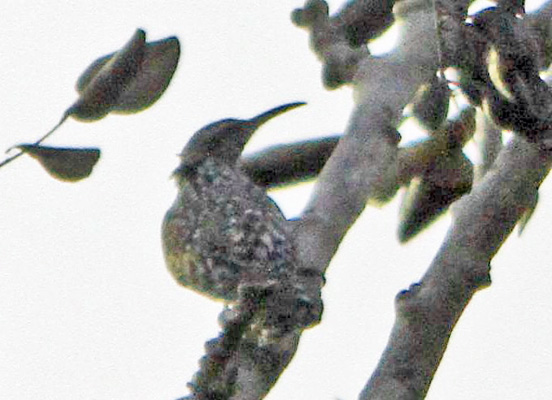
a web page by Don Roberson |
SPOTTED CREEPERS Salpornithidae |
||
|
||
For many years the two disjunct populations of Spotted Creeper — one in Africa and the other in India —were considered just one species. More recently authorities split them in two: Indian Spotted Creeper Salpornis spilonotus and African Spotted Creeper S. salvadori. Together they initially formed the subfamily Salpornithinae, but were elevated to Family level status by IOC and by eBird/Clements in 2024. This is African Spotted Creeper in Mole NP, Ghana (left). Here there was an oft-burned dry forest and this shot was taken in a burned patch with smoke and a low sun making poor, back-lit conditions. A much better photo from Ethiopia (below, © Adam Riley of Rockjumper Tours) is just below. |
||
 |
||
To quote Winkler et al. (2024), in Cornell's on-line Birds of the World, "The spotted creepers have had a surprisingly complicated taxonomic history, at times being placed with the smaller but similar-looking treecreepers (Certhiidae) or even with the nuthatches (Sittidae). In terms of physical appearance, the spotted creepers certainly remind observers of larger versions of the treecreepers, being similarly cryptically patterned and foraging in a similar way along the trunks and branches of tree, gleaning invertebrates from the bark. Unlike the treecreepers, however, they do not use their tail to brace against the tree and lack the characteristic stiffened tail feathers. . . . More research is needed to better understand their natural history, but the spotted creepers are known to build deep open cup nests that are held together with spider webs and insect cocoons and decorated with lichen, making them extremely cryptic. Little else is known about their breeding biology. Even their genetics is not yet entirely worked out, but evidence from a recent study by Oliveros et al. (2019) suggests that the spotted creeper clade was sister to Certhidae. In the 2024 taxonomy, the new Family is placed between the Nuthatches (Sittidae) and the Treecreepers (Certhiidae). |
||
Both Spotted Creepers occupy mature open woodland habitat. Large, rough-barked trees are required for breeding. Spotted Creepers are primarily insectivorous, "taking a wide assortment of small insects and spiders. Most food is obtained by gleaning and probing bark crevices on trees, with birds foraging on trees starting from the base and working their way upward. Frequently joins mixed species flocks" (Winkler et al. 2024). The distribution of African Spotted Creeper is local and uncommon. It occurs in the dry wooded savanna zone of West Africa, from Guinea to the Central African Republic -- northern Ghana, where I saw my only Spotted Creeper -- was within that portion of the Sahel. It also occurs very patchily in Ethiopia, western Kenya, very locally here and there in Tanzania and the Democratic Republic of the Congo. Its stronghold is probably the miombo woodland south of the Equator in Angola, Zambia, Zimbabwe, Malawi, and northern Mozambique. On my trip to Ghana in 2013 -- more than ten years before Family status was adopted by any global checklist -- I wanted to see a Spotted Creeper. I thought it was quite a unique bird -- might be a Family someday; who knows? -- and so much so that I offered a monetary reward to anyone finding me a Spotted Creeper on the trip. Our Rockjumper tour spent several days in Mole National Park in the north of Ghana. On the afternoon of our second day, our local guide Paul Mensah chose to take us out in a jeep along the Asibey Loop and Haraba track. We took along aother local guard with a gun to "protect us," they said, "from rouge elephants." We visiting various areas -- some of them burned and others burning -- in very dry thornscrub habitat. At some spots the flies and sweat-bees were almost intolerable, and we were glad to get out of there. We planned to stay until dark to look for nightjars. Quite late in the day, with the sun starting to set, we entered a burned area with scattered large trees. It was here, among acrid smoke and reddish haze, that Paul located a Spotted Creeper. The bird was quite cautious and jumpy, flying from tree to tree, but the experience was memorable, given the unusual birding crcumstances. Below are two more shots of that location: to the left is an unaltered photo from the camera, showing the smoky, back-lit conditions, and the other is my attempted enlargement of that creeper in that photograph, with PhotoShop, such as I could do. Not much in the way of a photo, but sometimes one is just happy that the bird was seen at all. I was very pleased to give Paul the reward money. |
||
|
||
Photos: The four photos of African Spotted Creeper Salpornis salvadori were, respectively, from Mole NP, Ghana, three taken by me on 12 Dec 2013, and the large second photo was by Adam Riley from Lake Awassa, Ethiopia. Bibliographic note:
Literature cited:
|
 The Spotted Creepers have traditionally been assigned to the Treecreeper family [Certhiidae]. The only other genus in this family is Salpornis, with two species of Spotted Creeper. They share some behaviors with other treecreepers but are a bit larger, heavier, and the tail is rounded and not used for support as in other treecreepers. Thus their behavior can appear more similar to a nuthatch. Both Spotted Creepers are marbled with black and white spots that provide some camouflage.
The Spotted Creepers have traditionally been assigned to the Treecreeper family [Certhiidae]. The only other genus in this family is Salpornis, with two species of Spotted Creeper. They share some behaviors with other treecreepers but are a bit larger, heavier, and the tail is rounded and not used for support as in other treecreepers. Thus their behavior can appear more similar to a nuthatch. Both Spotted Creepers are marbled with black and white spots that provide some camouflage. 

